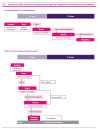COVID-19 vaccines - are we there yet?
- PMID: 33664546
- PMCID: PMC7900269
- DOI: 10.18773/austprescr.2020.084
COVID-19 vaccines - are we there yet?
Abstract
The novel coronavirus SARS-CoV-2, the cause of the COVID-19 pandemic, is a highly infectious human respiratory pathogen to which the global population had no prior immunity. The virus will likely continue to cause significant morbidity until there is a broadly effective vaccine As of mid-December 2020, more than 200 COVID-19 vaccine candidates are in development and 11 have entered phase III clinical trials globally. All generate immunity to the viral spike glycoprotein Three vaccine candidates have agreements for procurement and use in Australia if efficacy and safety requirements are met - one protein-based vaccine, one vaccine using a simian-derived adenovirus vector and one messenger RNA vaccine. The latter two vaccines have published interim analyses and efficacy results of their phase III trials. The messenger RNA vaccine is being rolled out in the UK, USA and Canada Significant uncertainties remain. How well will some of those at highest risk of severe disease (such as older people aged >75 years and those with immunocompromising conditions) be protected by a vaccine, and for how long? Also, to what extent will vaccination protect against infection? This will determine the degree of indirect 'herd' protection needed through broad vaccine coverage of younger age groups.
Keywords: COVID-19; clinical trials; coronavirus; immunisation; vaccine safety.
(c) NPS MedicineWise.
Conflict of interest statement
Katie Flanagan is a previous advisory board member for Seqiris and Sanofi Pasteur (in the last five years) and a member of the Australian Technical Advisory Group on Immunisation.
Figures
References
Publication types
LinkOut - more resources
Full Text Sources
Other Literature Sources
Research Materials
Miscellaneous


